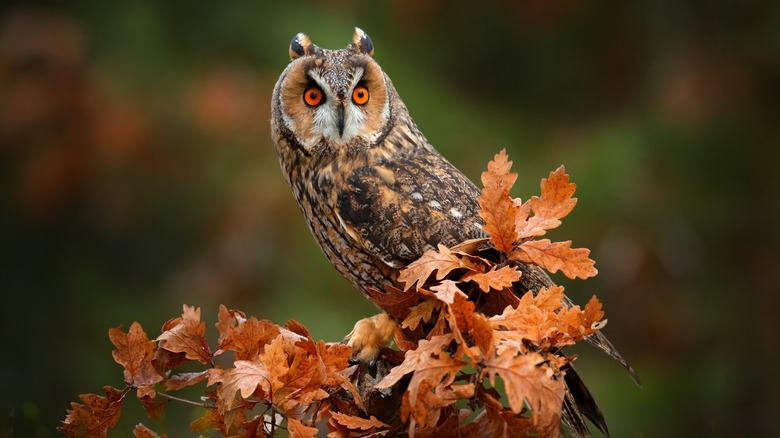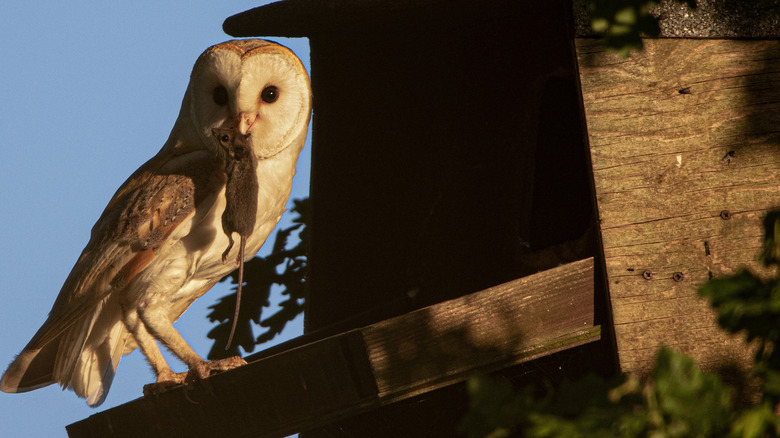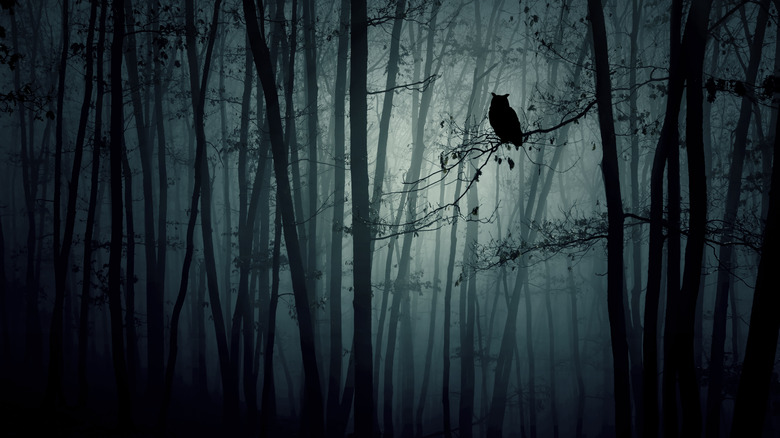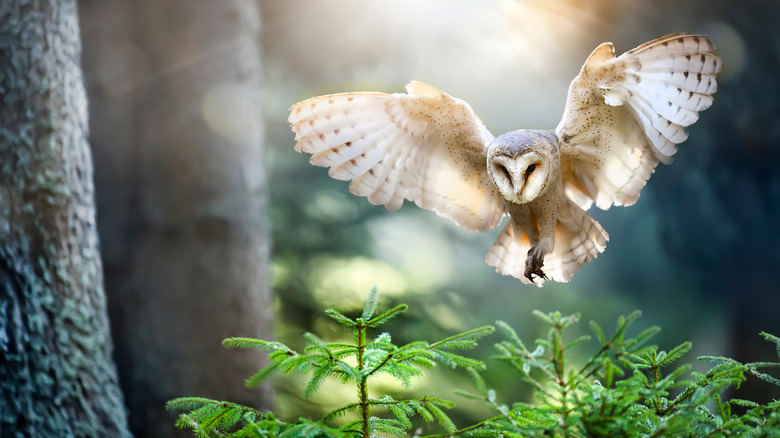How To Attract Owls To Your Yard And Why You Would Want To
Mysterious, elusive, elegant hunters — owls are majestic creatures that have appeared in mythology and folklore throughout Europe and the Americas for ages. They are also popular characters in children's books, perhaps because kids are unlikely to have any direct experience with them. Per The Guardian, this aloofness allows owls to be characterized well beyond the normal scope of most animal roles, often as the most intelligent and clever among the lot. In real life, people who are lucky enough to catch sight of an owl are often left speechless. Whether perched regally on a high tree branch or swooping low through a field, owls are revered for their prowess and perceived wisdom.
Yet they are much more than the characters they play in stories. They're aggressive hunters with a vital role in maintaining balance in the natural world. According to HGTV, owls prey on everything from small vermin to larger animals like rabbits and skunks; they also eat many insects. And since most are nocturnal, they take care of all of these pests before you wake up for your day. If you're a gardener, pay close attention to the following tips. There are many reasons why owls are suitable for the garden; however, it is essential to note that small pets and owls do not mix well. The larger of their species are very strong and have been known to carry away chickens. HGTV clarifies that they'll keep coming back until there is nothing left to eat.
Provide shelter
In the wild, owls will look for a hole in a decaying tree to use for resting and raising their little families. Installing a nesting box on your property helps attract these night creatures by offering them this kind of shelter in a pre-made and convenient fashion. If there's a specific type of owl you'd like to draw, you can adjust the size and location of your nesting box accordingly. Before investing, research the breeds native to your area and what they may like best. World Birds explains that these predominantly wooden boxes should be hung at least 10 to 20 feet high to keep predators like foxes and coyotes away from the nest.
Owls will be scouting out nesting options early in the year, before the end of winter, so it's best to install yours by February. Location really does matter, and keeping the shelter away from strong winds is also essential. Additionally, think of all those houseplants sitting in south-facing windows for sun exposure, and position your nesting box in a similar direction. The warmth from the sun will be beneficial to the nesting babies, known as owlets. One final tip from World Birds is to consider the flight path the birds will take to land either in the box or on a ledge just outside of it, and check the surrounding area for any structures or tree limbs that could make it difficult to access.
Create a safe environment
The Owl Research Institute has worked to safeguard owls and preserve their habitats for 33 years. They point out that since most owls are nocturnal creatures — meaning they are at their most active throughout the night — their eyes have evolved into seeing best in darkness. The owls' ability to hunt in the pitch-black of the night is part of what makes them such mighty predators. Peripheral light inside your home or on your porch will confuse these hunters mid-flight. As such, owls will not feel safe in a well-lit backyard. Furthermore, if you regularly keep bright lights on all night, such as flood lights, you're unwittingly keeping these creatures from coming anywhere near your property. Installing timers is a great way to keep you from forgetting to turn off all the lights.
Another factor to consider is the health of the birds once they've settled into your completely dark backyard. Chemical pesticides are potentially harmful to owls for two reasons. First, they kill off the same food they're looking to eat, making calories hard to come by. Second, owls can become poisoned after eating pests that have been envenomed. The owls will be there to take care of any rodent problems you have — it's literally what they do. So refrain from using rodenticide as well. The Owl Research Institute reminds us that the top priority should always be the safety of these beloved creatures instead of our excitement over having them nearby.
Allow for natural sources of food
You're unlikely to stay too long in a place without enough food to go around, and the same goes for owls. Allowing for natural food sources is an excellent way to ensure the repeated return of these ethereal birds. However, a flower garden and a bird feeder full of seeds will not cut it when it comes to owls. As carnivorous raptors, owls primarily hunt small rodents. So you'll need to invite their prey to the party before you can expect any owls to arrive. This may seem counterintuitive, especially if you're an avid gardener, but consider the more outstanding balance of the natural and trust the birds to do their work.
Per the Bird Informer, tall grasses, unmowed sections of lawn, and brush piles will attract small rodents like tasty mice and voles by giving them places to hide — think of it as feeding your guests. While these areas may appear messy, The Owl Research Institute says to keep them free of actual trash. Brush piles should only be made up of organic elements such as raked leaves and grass trimmings. Be sure to remove any manufactured materials, like plastic or styrofoam, that may get mixed in. As for location, you'll want your brush pile to be a significant distance from your house, shed, greenhouse, or garage. You want to welcome the little critters to your yard without extending the invitation indoors.



